SWINGS PARTS
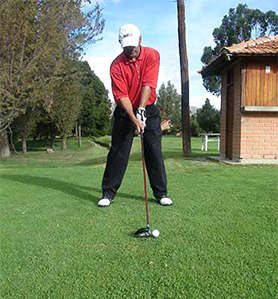
SET UP
To aim accurately, sole the clubhead behind the ball and point the face at your target, then set your stance perpendicular to the face.
- With a driver, play the ball just inside your front foot. That, combined with a slight tilting of your upper body away from the target, will promote a high launch.
- Stay loose by keeping your arms and legs in motion as you stand over the ball. Good drives come when you maximize your freedom of motion.
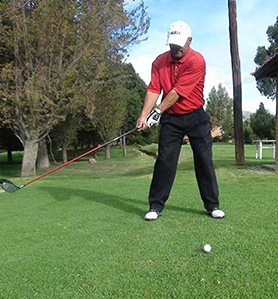
TAKEAWAY
A good start to the swing is essential. Get it wrong, and everything can go south (apart from the numbers on the scorecard):
- Start your hands, arms and shoulders back together for maximum efficiency; don’t let your hands take over the swing.
- When the club reaches parallel to the ground, the clubhead should be in line with or just outside your hands. This means the swing is on plane, setting up solid contact and good direction.
- Turn your shoulders on the downward angle they were at setup rather than level to the ground. The latter would make your swing too flat and inside.
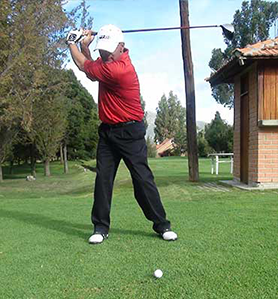
BACKSWING
The better the backswing, the simpler the move back to the ball. Here’s how to get there:
- Stay in your address angles. If you lift out of your posture, you have to drop down the same amount before impact, or else risk making poor contact.
- Keeping the right leg flexed as weight is shifting onto it ensures that the body is coiling and storing energy.
- If your club reaches parallel to the ground at the top, it should point about at your target. That means your swing has stayed on plane, and you won’t have to make any downswing compensations.
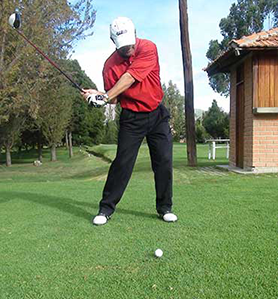
DOWNSWING
The return to the ball takes only milliseconds, so make it count:
- A good indicator of power is when the lower-body turn is leading the upper-body turn. If they unwind together, you leave yards on the table.
- Keep your right elbow close to your body as the club moves down to make sure the club stays on an inside path to the ball.
- When you maintain the angle between your left arm and the shaft as you swing down, you have what’s called “clubhead lag.” The more you lag it, the more acceleration you’ll have at the bottom of the swing.
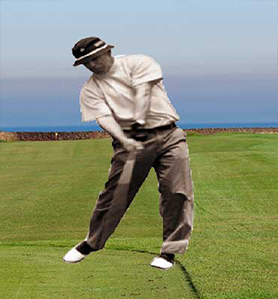
IMPACT
The moment of truth! Here’s what to focus on:
- Good compression of the ball comes from a good weight transfer. Feel as if you’ve shifted all of your weight from your back foot to your front by impact.
- The clubface should be rotating closed as your right arm extends and starts to roll over the left.
- Swinging the club out to the ball from the inside will promote an easy, repeatable draw.
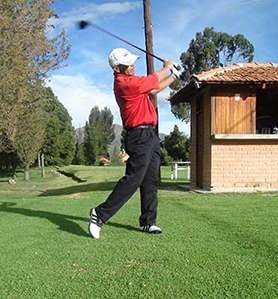
FOLLOW-THROUGH
Want to look good for the cameras? Try these tips:
- After impact, your arms should be fully extended toward the target. That’s a sign that you’ve expended all of the energy you created in the backswing.
- Your weight should be firmly planted onto a stable front leg.
- Body rotation shouldn’t stop at impact. Your torso should continue turning left even as the ball flies down the fairway.
Should be long to prevent injury, whole body should face the target, club should finish over the front shoulder, should still be balanced and ball should no longer be on the tee!

CHIP
No need for anything fancies here. Keep the motion compact and simple:
- Set up with more of your weight on your front side, with the ball off your back foot. That’ll help you hit down or solid contact.
- Keep your wrists firm and your hands ahead of the clubhead. Less hand action will make it harder to thin or chunk the shot.
- A good way to avoid decelerating is to keep your upper body turning through the shot. Your chest should face the target at the finish.
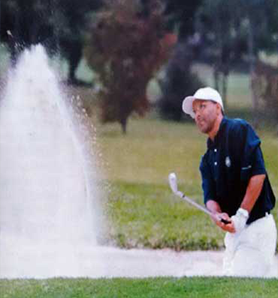
BUNKER SHOT
Bunkers are intimidating, until you learn how easy this shot can be:
- The sand is unstable, so build a solid foundation. Take a wide stance, and really dig in your feet.
- You’re not actually hitting the ball on bunker shots–you’re hitting the sand just behind the ball—two or four fingers so you need to make a big swing back and through.
To hit high, soft bunker shots, the clubface must slide under the ball. To make this happen and avoid digging too deep, sling the clubhead past your hands through impact.
PUTT
Putting with feel won’t happen unless you feel good. Here’s how:
- Set up with your eyes over the ball and your hands hanging directly under your shoulders. This relieves tension and promotes a repeatable stroke.
- The putter head should move pretty much straight-back and straight-through, beginning to move on a slight circular arc only as the stroke gets longer.
- To avoid any decelerating or over-accelerating during the stroke, focus on swinging the putter at a steady pace and about the same amount on each side of the ball.
